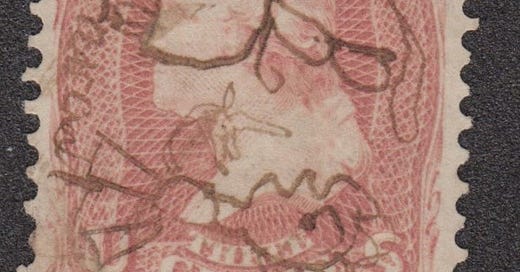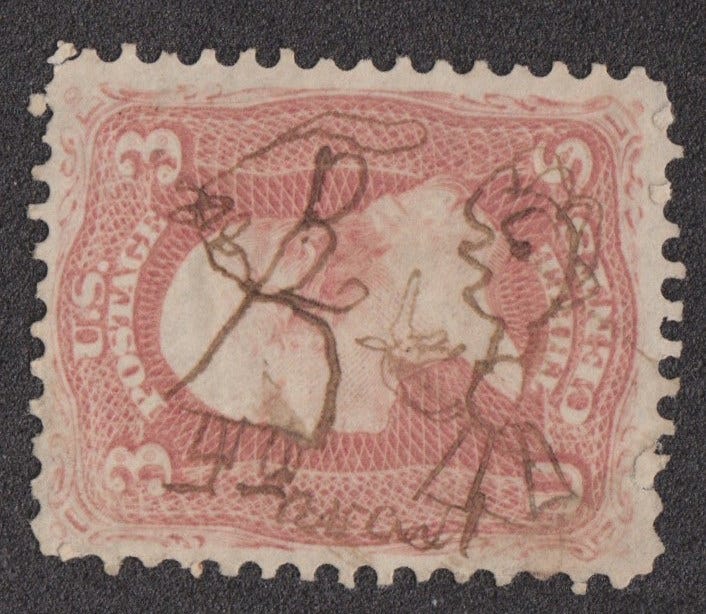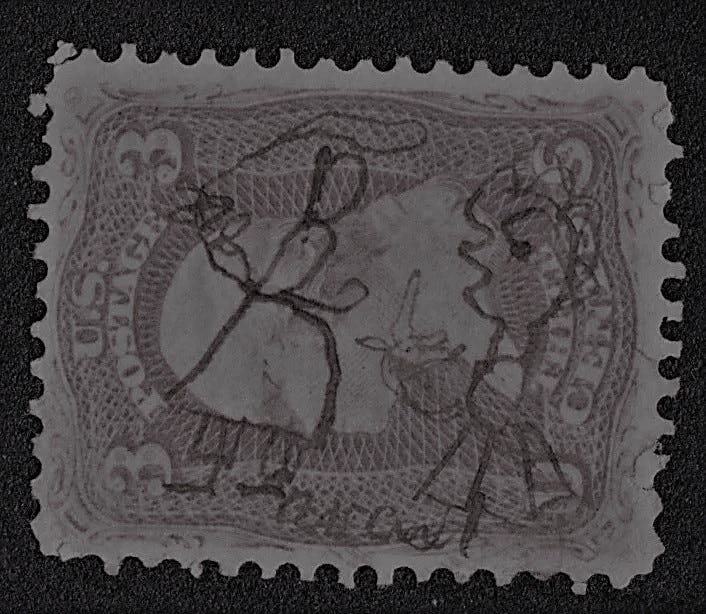The imagination is a powerful thing — particularly when it’s combined with wishful thinking. This is particularly true with the area that deals with fancy cancels on 19th-century stamps.
I belong to several stamp collecting groups on Facebook and I never cease to be amazed at what “amazing and undiscovered” “fancy cancels” show up — particularly when most are demonstrably nebulous blobs of ink applied by a harried postmaster to simply cancel a stamp and move the mail along. Even the pioneers of this area, in my opinion, were occasionally guilty of calling a smear a swan or a blob a bear. This is borne out by some of the tracings found in the standard references.
Let’s face it, while there are many hundreds of very distinct and specific fancy cancels that cannot be mistaken for what they are, such as a “running chicken,” there is a great deal of subjective judgment about what is represented by the splotch on a stamp. I simply refer to it as a philatelic Rorschach test, and I’m not immune to it, either. There have been times I’ve fallen prey to seeing something other than what’s plainly in front of me in my quest for an odd piece.
For the most part, these flights of whimsical wishful thinking are harmless, but I do see some of them offered for real money online — with the occasional buyer, as well. But I digress.
One type of fancy cancel I very much like to analyze is a mysterious manuscript cancel. For obvious reasons, there is no “guide” for these items, which rarely turn up.
To that end, I thought I’d pull my all-time favorite example out of the album for a fresh look. That stamp, shown below, was purchased some years ago from an American Philatelic Society circuit sales book. It was described as having a “whimsical postal cancel.” The stamp immediately spoke to me as something special, although I had no idea why at first. These weren’t just random Civil War-era scribblings on a common 19th-century stamp, but what were they?.
At first glance, the 3¢ 1861 (Scott 65), has a bit of doodling that gives George Washington a bow tie and perhaps a mask. This is odd, but not rare. The ink is the dark brown iron gall ink in use at that time, and it wasn’t unusual for 19th-century postmasters to occasionally doodle on stamps. Some very small post offices didn’t have postmarking devices, so postmasters canceled everything with manuscript cancels. Sometimes they had too much time on their hands. Many of these “poor man’s fancy cancels” were created out of sheer idleness, boredom or as a novelty.
But there was something about this particular stamp’s cancel that was different from others I’ve encountered. There was more to the doodling than simply a bow tie and mask, but the relative small size of the stamp and drawing made it difficult to see at first. After turning the stamp several different directions to orient possible letters, it finally occurred to me that this was not simple ornamentation, it was an illustration.
When the stamp is turned on its side, as shown enlarged above (then with the stamp image partially filtered out), a really unusual scene plays out. The figure at left appears to be a female in a dress (perhaps with a bonnet), twirling a lasso over her head. The figure at right, a curly haired male holding a candle, is looking at her with a rather surprised expression. Beneath the figures a word has been written, which appears to read “rascal.” Could it be the doodled male is coming home late from a night of carousing (thus holding the candle), only to be surprised by his angry wife who is brandishing a lasso? And why would this scene appear on a stamp?
Another unusual aspect of this cancel is that the drawing style appears to be that of a juvenile, rather than an adult. This is apparent in several areas of the drawing, including the female’s feet (below the bottom of the skirt), which turn the opposite direction from the body. Is it possible that some small-town postmaster in the 1860s was that hapless husband in the illustration (the rascal), who — as a form of atonement — was obliged to let his child accompany him to the post office? If so, did he allow his child to doodle on the outgoing mail?
After featuring this stamp elsewhere, I received some interesting feedback, including additional opinions on my interpretation, as well as what is shown.
One person agreed with my basic assessment of the scene, but posited that the female figure is indeed twirling a lasso, but not as punishment; she is trying to catch a man (the male figure), who is presumably presenting a gift of some sort.
While this is certainly not a random blob of ink, it is certainly open to interpretation. What do you see?







Fascinating.
I can't make out "Rascal" at the bottom, but the letters (if that is what they are) look too regular to have been written by the same child who drew the figures. Also not sure how a child who drew those figures could spell.